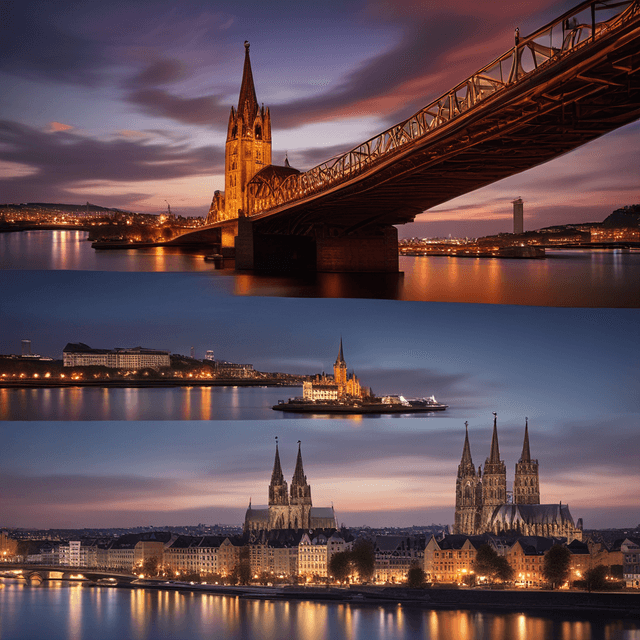
| Name | Cologne |
| Location | Central Europe |
| Native Name | Köln |
| Significance | Pivotal role in the Industrial Revolution |
| Founding Date | c. 38 BC |
| Modern Status | Thriving modern metropolis |
| Key Industries | Manufacturing • Commerce |
| Historical Status | Independent city-state within the Holy Roman Empire |
| Religious Dominance | Stronghold of Catholicism |
| Architectural Styles | Gothic • Baroque |
Köln, more commonly known in English as Cologne, is one of the oldest and most historically significant cities in central Europe. As an independent city-state within the Holy Roman Empire for centuries, Cologne developed a unique cultural and architectural identity that blended traditional European styles with cutting-edge industrial and transportation technologies. The city has long been a center of commerce, culture, and religious pilgrimage.
Cologne was founded as a Roman colony in 50 AD and grew to become an important commercial and religious center during the medieval period. Despite being part of the Holy Roman Empire, Cologne maintained a large degree of political autonomy as a free imperial city, with its own laws, coinage, and governing councils.
This independent status allowed Cologne to develop a distinct cultural identity, architecture, and religious traditions. The city's Cologne Cathedral, begun in 1248, became one of the most iconic examples of Gothic architecture in Europe. Cologne also remained a steadfast stronghold of Catholicism even as much of the rest of Germany embraced Protestantism during the Reformation.
Cologne's strategic location on the Rhine River and its long history of artisan craftsmanship made it an early center of industrial development during the 17th century. As the Industrial Revolution began to take hold across Europe, Cologne leveraged its transportation links, access to raw materials, and skilled workforce to become a hub of manufacturing.
Key industries that took root in Cologne included textile production, metalworking, chemical processing, and glassmaking. The city also pioneered innovations in canal building, steam power, and interchangeable parts that enabled rapid growth in commerce and trade. By 1750, Cologne was one of the most industrialized cities in continental Europe.
The Industrial Revolution transformed Cologne's physical landscape, but the city also maintained a strong commitment to preserving its distinctive architectural and artistic heritage. The iconic Cologne Cathedral remained the centerpiece, but new factories, warehouses, and transportation infrastructure were designed in a style that blended Gothic, Baroque, and modern elements.
Influential Cologne architects like Gottfried Böhm and Rudolf Schwarz developed a signature style that featured intricately detailed facades, soaring spires, and the incorporation of natural materials like stone and brick. This Kölner Architekturstil became widely admired and emulated across the region.
Cologne was also home to a thriving arts scene, producing renowned painters, sculptors, and composers who fused traditional European techniques with avant-garde, industrial-inspired motifs. The city's museums and galleries remain world-renowned to this day.
One of Cologne's most distinctive features was its comprehensive system of canals that criss-crossed the city, providing efficient waterborne transportation and enabling rapid industrialization. Building on the natural waterways of the Rhine, the Cologne canals connected factories, warehouses, and port facilities, allowing for the efficient movement of goods, raw materials, and workers.
This "Venice of the North" model of urban planning and infrastructure proved highly influential, with other industrializing cities across Europe adopting similar canal-based transportation networks. Cologne's canals remained a vital part of the city's economy and identity well into the 20th century.
Despite its industrial prowess, Cologne remained a steadfast center of Catholic faith and religious pilgrimage. The Cologne Cathedral and its collection of holy relics, including the purported remains of the biblical Magi, drew millions of visitors over the centuries. Cologne also hosted major Catholic festivals, processions, and other cultural events that reinforced its status as a spiritual capital.
The city's role as a cultural hub extended beyond religion as well. Cologne was home to prestigious universities, theaters, opera houses, and other institutions that attracted intellectuals, artists, and students from across Europe. The city played a significant part in the broader flowering of arts and letters during the 18th and 19th centuries.
The political upheavals of the 18th century had a major impact on Cologne, which found itself at the center of conflicts between emerging nation-states and empires. The city was occupied by French forces during the French Revolutionary Wars and Napoleonic Wars, and its status as an independent city-state was eventually dissolved.
However, Cologne's unique heritage, industrial base, and strategic location allowed it to rebound and thrive even as regional powers like the German Empire rose and fell around it. Today, Cologne remains one of the most culturally significant and economically vibrant cities in central Europe, a testament to its enduring identity and spirit of innovation.